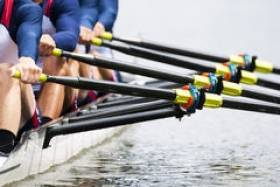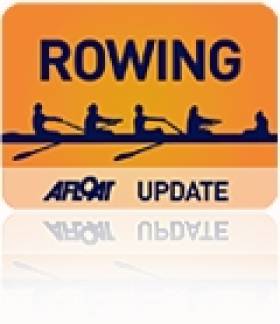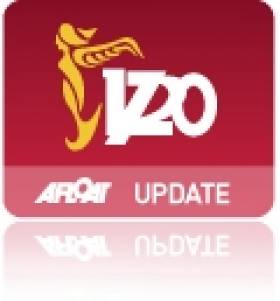Displaying items by tag: World Championships
Under-23 Quadruples Chosen for World Championships
#Rowing: The men's under-23 lightweight quadruple which won on both days at the London Metropolitan Regatta at Dorney Lake has been given the nod by the Ireland selectors for the World Championships in Rotterdam in August. The heavyweight quadruple will also travel. A big team has also been chosen for the World University Championships in Poznan, Poland in early September. There is a strong-looking women's four and men's double, and Monika Dukarska has been chosen in the single sculls.
Ireland Crews Nominated for International Events
World Championships, August 21st to 28th, Rotterdam
Men: Under-23 Quadruple - S McKeown, J Casey, P Boomer, D Buckley. Lightweight Under-23 Quadruple - S O'Connor, S O'Connell, C Hennessy, F McCarthy.
Coupe de la Jeunesse, Poznan, July 29th-31st
Women - Junior Pair: A Mason, T O'Hanlon
World University Championships, September 2nd - 4th, Poznan
Men, Sculling - Double: P Doyle, T Oliver. Under-23 Lightweight Double: J McCarthy, D Synott. Single: A Goff. Lightweight Single: C Beck.
Women - Four: A Feeley, E Lambe, S Bennett, K O'Connor.
Sculling - Double: O Blundell, A Crowley. Single: M Dukarska.
Ireland Lightweight Doubles are Afloat Rowers of the Month
#Rowers of the Month: The Afloat Rowers of the Month for September are the Ireland men’s and women’s lightweight double sculls (Paul and Gary O’Donovan; Sinéad Jennings and Claire Lambe) which qualified their boats for the Olympic Games. Both crews faced challenges in their quest to be in the top 11 at the World Championships in Aiguebelette; both overcame them.
Jennings, a mother of three young children and a doctor, returned to the sport last year targeting a place in Rio. She broke a rib early this year. For another athlete this might have meant abandoning her punishing schedule. Jennings (then 38) redoubled her efforts. She excelled on the Wattbike at the Irish Indoor Championships and competed at the European Championships in a lightweight single. She came through a two-race trial to qualify for the lightweight double. Lambe and Jennings teamed up at the World Cup in Lucerne and finished seventh. It was a promising result, but this was their first time competing together. In the semi-final at the World Championships, they were outsprinted to the line by Canada, and missed out on an A Final spot. For the B Final, the tactics were to be in the leading group until the end. They did it. Their third place secured the precious slot in Rio for the Ireland women’s lightweight double.
Paul and Gary O’Donovan produced one of the greatest performances in Irish rowing by taking third place in their quarter final in Aiguebelette. With just a season of competition as a crew behind them, Gary (22) and Paul (21) were able to find a sprint finish which ousted New Zealand from a chance of qualifying their boat. In the B Final, the O’Donovan brothers stayed with the leaders until the finishing sprint, where they showed tremendous grit to take fifth (11th overall), .28 of a second ahead of Greece.
Well done to all the Ireland team and to the two crews which are the Afloat Rowers of the Month.
Rower of the Month awards: The judging panel is made up of Liam Gorman, rowing correspondent of The Irish Times and David O'Brien, Editor of Afloat magazine. Monthly awards for achievements during the year will appear on afloat.ie and the overall national award will be presented to the person or crew who, in the judges' opinion, achieved the most notable results in, or made the most significant contribution to rowing during 2015. Keep a monthly eye on progress and watch our 2015 champions list grow.
Jegou's Penalty-Free Run Not Fast Enough To Secure Olympic Place
#Canoeing: Ireland C1 paddler Liam Jegou finished outside the top 10 nations at the canoe sprint World Championships in Lee Valley in England today and missed out on this chance of qualifying the boat for the Olympic Games. Jegou went off second in his semi-final and had a penalty-free run down the course, but his time of 106.29 seconds was not fast enough to stand in the top 10 nations. Jegou came in 27th, ahead of Italy and Canada. Spain, Portugal and Australia also missed out.
Canoe Slalom World Championships, Lee Valley, London, Day Five (Irish interest)
Men
C1 – Semi-Finals (10 to Final): 27 L Jegou 106.29
K1 – Team Final: 19 Ireland 161.62
Ryan Best of Irish K1 Competitors at Canoe Slalom World Championships
#Canoeing: Cade Ryan was the most impressive of Ireland’s three competitors in the K1 at the canoe slalom World Championships in Lee Valley in England today. Ryan clocked 90.42 seconds and 89.69 in the two runs, with no penalties on either. Elliott Davidson and Sam Curtis were pushed well down the rankings, through penalties on both runs.
Canoe Slalom World Championships, Lee Valley, London, Day Three (Irish interest)
Men
K1 – First Run (top 30 to Semi-Finals): 60 C Ryan 90.42; 98 S Curtis 145.17 (incl 54 seconds penalty); 102 E Davidson 203.59 (incl 104 sec pen). Second Run (10 qualify): 27 Ryan 89.69; 41 Davidson 99.06 (incl 6 sec pen); 65 Curtis 146.05 (incl 56 sec pen).
Liam Jegou Excels in Second Run to Claim Semi-Final Place at World Championships
#Canoeing: Liam Jegou qualified for the semi-final of the canoe slalom World Championships in Lee Valley, England today. The France-based teenager produced an impressive, penalty-free, second run in the C1 to place ninth, with 10 places available. In his first run, he incurred penalties on gates eight and 11 and had four seconds in penalties, but would have fallen outside qualification in any case. Jake Cochrane placed 68th and 64th in his two runs.
Canoe Slalom World Championships, Lee Valley, London, Day Two (Irish interest)
Men
C1 – First Run (top 20 to semi-finals): 37 L Jegou 95.98 seconds (incl 4 sec pen); J Cochrane 161.15 (incl 54 sec pen). Second Run (10 qualify): 9 Jegou 90.83; 64 Cochrane 108.38 (incl 8 sec pen).
Women
C1 – First Run (top 15 to semi-finals) 32 C O’Ferrall 191.62; Second Run: O’Ferrall 132.14 (incl 4 sec pen)
Craig One Touch From Semi-Final at World Championships
#Canoeing: Ireland’s Hannah Craig came close, but missed out on qualifying for the semi-finals of the women’s K1 at the canoe slalom World Championships in Lee Valley in England today. She came down the course in 97.04 seconds on her first run, but a touch on gate 11 took her to 99.04 seconds, and pushed her out of the top 20, who qualified. The second run had just 10 qualifying places available. Craig finished 21st, with a penalty-free run of 100.4 seconds.
Canoe Slalom World Championships, Lee Valley, London, Day One (Irish interest)
Women
K1 – First Run (20 qualify): 30 H Craig 99.04 seconds (incl 2-sec penalty); 2nd Run (10 qualify): 21 H Craig 100.4 sec.
Jenny Egan Fourth at Canoe Marathon World Championships
#Canoeing: Jenny Egan finished fourth in the senior K1 event at the Canoe Marathon World Championships in Gyor in Hungary. Anna Koziskova of the Czech Republic took gold, covering the 26.1 kilometre course in one hour 56 minutes 28.847 seconds, while Egan was three minutes and just under 50 seconds further back. Egan was 57 seconds behind bronze medallist Kristina Bedec of Serbia.
Canoe Marathon World Championships, Gyor, Hungary
Men
K1 Senior, 30km: 25 P Egan 2 hrs 15 min 24.477sec ; B Watkins dnf. K1 Under-23, 26.1km: 18 T Brennan 1:56.378.177
Women
K1 Senior, 26.1km: 4 J Egan 2:00.18.166.
Puspure So Close To Olympic Qualification at Aiguebelette
#Rowing: Sanita Puspure came up just short of gaining Olympic qualification for the Ireland single scull in a tight finish of the B Final at the World Championships in Aiguebelette in France this morning. The Old Collegians woman carved out an impressive lead of just over a length after 500 metres and held it until the final quarter. Just three from this race would qualify boats for Rio, and the field caught Puspure coming up to the finish. On the line, Puspure took fifth, .66 of a second behind third-placed Magdalena Lobnig of Austria.
World Rowing Championships, Aiguebelette, France – Day Eight (Irish interest)
Men
Lightweight Four - B Final (Places 7 to 12): 3 Britain (2 P Chambers) 5:56.29.
Single Sculls – B Final (Places 7 to 12): 2 Britain (A Campbell) 6:46.68
Women
Single Sculls – B Final (Places 7 to 12): 1 Sweden 7:26.60, 2 Lithuania 7:27.30, 3 Austria 7:27.52; 4 Belarus 7:27.86, 5 Ireland (S Puspure) 7:28.18, 6 Zimbabwe 7:31.74.
Two Ireland Boats Qualify for Olympic Games
#Rowing: Ireland qualified two boats for the Olympic Games at the World Rowing Championships in Aigubebelette in France. The lightweight men’s and women’s doubles had to finish in the top 11 to qualify, which meant a place in the top five of their B Finals.
The lightweight men’s crew of Paul and Gary O’Donovan took the final place. In a tense race, where the boats were tightly packed for much of the 2,000 metres, the O’Donovan’s sprinted to the line taking fifth just ahead of Greece – the margin was .28 of a second.
In the women’s race which followed, Ireland’s Sinead Jennings and Claire Lambe carved out a clear lead in the second quarter and held it until the pack caught them coming towards the line. However, the Irish were determined not to miss their chance, and took third behind China and Poland. This placed them ninth in the world.
World Rowing Championships, Aiguebelette, France – Day Seven (Irish interest)
Men
Lightweight Double Sculls – B Final (Places 7 to 12): 1 Poland 6:20.25, 2 United States 6:20.55, 3 Austria 6:22.04, 4 Switzerland 6:22.34, 5 Ireland (P O’Donovan, G O’Donovan) 6:23.20; 6 Greece 6:23.48.
Women
Lightweight Double Sculls – B Final (Places 7 to 12): 1 China 6:59.31, 2 Poland 7:00.37, 3 Ireland (C Lambe, S Jennings) 7:00.67, 4 Russia 7:00.79, 5 United States 7:02.21; 6 Sweden 7:02.45.
Ireland Double Win D Final and Walsh Takes Second in C Final in Aiguebelette
#Rowing: Ireland’s women’s double and lightweight single sculler Denise Walsh finished their campaigns at the World Rowing Championships in Aiguebelette in France with good performances. Walsh took second in her C Final, 14th overall. She sprinted to the line and almost caught winner, Kate Johnstone of South Africa. Helen Hannigan and Lisa Dilleen won their D final, pushing Italy into second. The Ireland crew places 19th overall.
World Rowing Championships, Aiguebelette, France – Day Six (Irish interest)
Men
Lightweight Four – Semi-Final Two (First Three to A Final): 4
Britain (2 P Chambers) 6:58.68.
Lightweight Pair – A Final: 1 Britain (J Cassells, S Scrimgeour) 6:29.40. B Final (Places 7 to 12): 1 Ireland (M O’Donovan, S O’Driscoll) 6:46.44, 2 Spain 6:46.59, 3 Czech Republic 6:47.54.
Single Sculls – Semi-Final Two: 5 Britain (A Campbell) 6:51.24.
Women
Four – A Final: 1 United States 6:25.22, 2 Britain 6:31.52, 3 China 6:35.56; 5 Ireland (A Keogh, M Dukarska, L Kennedy, B O’Brien) 6:43.49.
Double Sculls – D Final (Places 19 to 24): 1 Ireland (H Hannigan, L Dilleen) 7:17.04, 2 Italy 7:18.38, 3 Ukraine 7:21.82.
Single Sculls – Semi-Final (First Three to A Final; rest to B Final): 1 China 7:24.41, 2 Czech Republic 7:26.48, 3 United States 7:27.39; 5 Ireland (S Puspure) 7:33.94.
Lightweight Single Sculls – C Final (Places 13 to 18): 1 South Africa 8:07.16, 2 Ireland (D Walsh) 8:07.96.































































